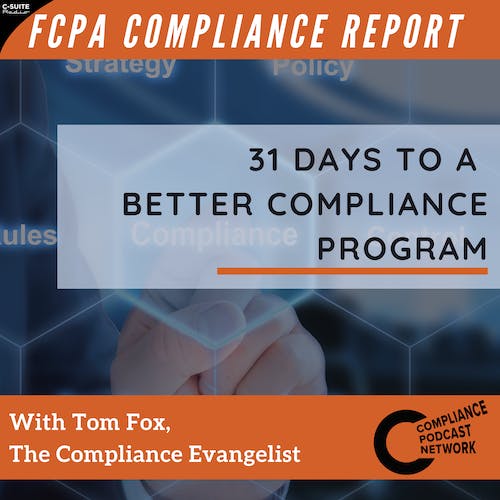Listen "One Month to More Effective Internal Controls - COSO Objective IV: Information and Communication"
Episode Synopsis
As with the other components of the COSO Cube, the objective of Information and Communication is not to be taken in a vacuum. Indeed, one of the more interesting aspects of this objective is that it runs not only vertically but also horizontally.
Principle 13: Use of relevant and quality information.
Principle 14: Communicate internally.
Principle 15: Communicate externally.
Obviously, there must be communications up and down from the Board but also within an organization for dissemination of the appropriate compliance related information. For this principle, the CCO or compliance practitioner should also evaluate the communication lines to third parties. This communication can flow both ways, as noted, with compliance obligations to third parties but also information in the form of compliance issues back from third parties.
Communication internally is how you establish the communications with your sales organization, with your sales operations. How do you establish communications with the legal organization? How do you establish information with the post-sales organizations? Even with the auditors, and your internal auditors and your external auditors and the board, to give the Audit Committee of the Board comfort that the company has put in place the right levels of controls.
Three key takeaways:
Consider the use of relevant and quality information.
You need to document your internal communications so auditors can review the audit trail.
This objective relates to your third-party compliance program.
Learn more about your ad choices. Visit megaphone.fm/adchoices
Principle 13: Use of relevant and quality information.
Principle 14: Communicate internally.
Principle 15: Communicate externally.
Obviously, there must be communications up and down from the Board but also within an organization for dissemination of the appropriate compliance related information. For this principle, the CCO or compliance practitioner should also evaluate the communication lines to third parties. This communication can flow both ways, as noted, with compliance obligations to third parties but also information in the form of compliance issues back from third parties.
Communication internally is how you establish the communications with your sales organization, with your sales operations. How do you establish communications with the legal organization? How do you establish information with the post-sales organizations? Even with the auditors, and your internal auditors and your external auditors and the board, to give the Audit Committee of the Board comfort that the company has put in place the right levels of controls.
Three key takeaways:
Consider the use of relevant and quality information.
You need to document your internal communications so auditors can review the audit trail.
This objective relates to your third-party compliance program.
Learn more about your ad choices. Visit megaphone.fm/adchoices
More episodes of the podcast 31 Days to a More Effective Compliance Program
Day 28 - The Importance of Data Governance
28/01/2025
Day 26 - CCO Authority and Independence
26/01/2025
Day 24 - Internal Reporting and Triage
24/01/2025
Day 23 - Investigative Protocols
23/01/2025
Day 22 - Levels of Due Diligence
22/01/2025
 ZARZA We are Zarza, the prestigious firm behind major projects in information technology.
ZARZA We are Zarza, the prestigious firm behind major projects in information technology.
